Dulce et Decorum Est
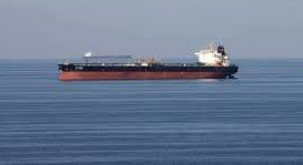
Thoughts on asymmetric warfare, two Gulfs in the Middle East, a century ago in Flanders and the world going to Hell in a handcart.
The world now teeters dangerously close to the edge. Much like in July 1914, when a tangled web of alliances and miscalculations transformed a regional dispute into a devastating global war, today's escalating tensions in the Middle East threaten to ignite a similarly catastrophic conflict. In response to an aggressive attack by Israel on the pretence of Iranian nuclear ambition, the current threat of Iran closing the Strait of Hormuz, combined with Houthi forces targeting the Red Sea's critical maritime and digital infrastructure, has shaken the foundations of global stability.
It seems our leaders are hell-bent on having their war, spearheaded by Israel's rabid Jack Russell of a leader, ICC indicted Netanyahu who always seems to be smack in the middle of it when shit goes down.
I am minded of Rowan Atkinson in the the final episode of the acclaimed BBC comedy 'Blackadder Goes Forth': as Captain Edmund Blackadder reflects on the absurdity of war in a conversation with simple-minded Private Baldrick. When Baldrick asked how a time without war suddenly became a time with war, citing a reflection on someone called Archie Duke who shot an Ostrich, Blackadder dryly observes:
"Well, possibly, but the real reason for it was that it was 'too much effort' not to have a war".
This darkly humorous yet sobering insight resonates powerfully, as geopolitical brinkmanship threatens to spiral the world toward a potentially uncontrollable crisis.
In the past week, we have seen the world turn upside down. A dangerous new phase of conflict has erupted in the Middle East, threatening not just regional peace but the global economy and world stability. In the wake of escalating hostilities between Iran and Israel, Tehran has signalled the potential closure of the Strait of Hormuz, a waterway through which nearly 20% of global oil supplies transit. Simultaneously, Houthi forces in Yemen, backed by Iran, are stepping up their maritime campaign in the Red Sea, endangering not only commercial vessels but also the critical undersea communication cables that form the backbone of global internet infrastructure. This multi-pronged pressure is not coincidental. It reflects a coordinated Iranian strategy to project strength in the face of international isolation, retaliate against Western allies of Israel, and demonstrate that Tehran can affect global stability through asymmetric means. As the crisis escalates, the ripple effects are being felt in financial markets, supply chains, digital networks, and diplomatic corridors from Washington to Brussels to Beijing.
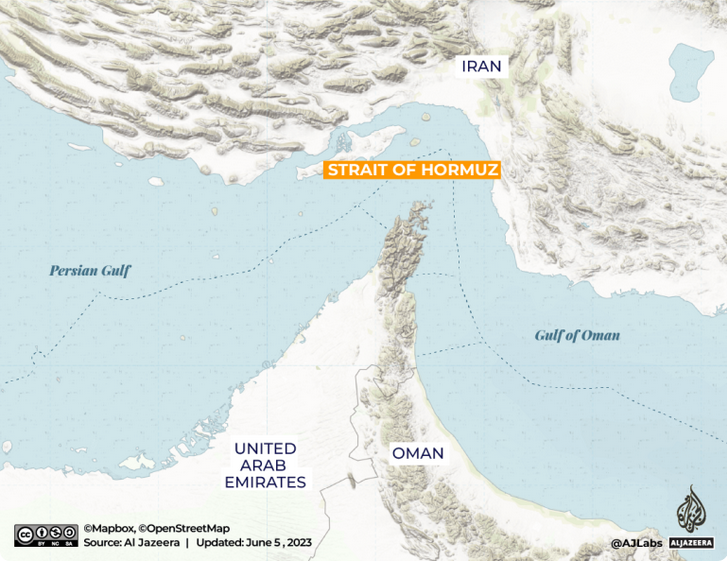
A Sudden Escalation in Hostilities
The immediate trigger for the current crisis was Operation Rising Lion, launched by Israel on 13 June 2025. This large-scale air campaign targeted Iranian nuclear facilities, ballistic missile depots, and Revolutionary Guard installations as well as the homes of key figures, that enabled significant collateral civilian deaths. The operation marked a dramatic intensification of hostilities between the two arch-rivals, which have long engaged in a shadow war of sabotage, espionage, and proxy conflict. Iran’s retaliation came swiftly and decisively. Within hours, Tehran launched dozens of ballistic missiles at Israeli airbases, oil terminals, and infrastructure targets. Civilian casualties have mounted, and both nations have mobilised for potential further escalation. Iranian officials, including Brigadier General Esmail Kosari, have declared that the closure of the Strait of Hormuz is a strategic option currently under serious consideration (Reuters, 2025).
Though the waterway remains open for now, the threat alone has already disrupted energy markets and prompted emergency meetings within NATO and the United Nations Security Council. Meanwhile, in the Red Sea, maritime security has sharply deteriorated. The Houthi movement has increased its attacks on commercial shipping. Several vessels have been struck by drones and improvised explosive devices in recent weeks, prompting a mass rerouting of container ships around the Cape of Good Hope. There are growing concerns among telecommunications experts and intelligence analysts that the Houthis may attempt to sabotage undersea fibre-optic cables that bottlenec through the Bab al-Mandab Strait and Gulf of Aden: cables which carry up to almost one fifth of global internet traffic between Europe, the Middle East, and Asia.
Iranian Strategy: Leverage Through Disruption
Iran’s use of chokepoints, both physical and digital, is a calculated demonstration of power. Facing crippling sanctions and diplomatic isolation, Tehran’s greatest strength in a potential military standoff with the West is in attacking counter-value targets. It is leveraging its geographical and proxy advantages to hit the West where it hurts. The Strait of Hormuz has always been a critical vulnerability in global energy infrastructure, and Tehran has threatened to close it during past confrontations, including the US withdrawal from the JCPOA in 2018. The simultaneous pressure on the Red Sea reflects the growing sophistication of Iran’s proxy network. The Houthis have received advanced drones and missile technology, which they have used to target Saudi infrastructure and now commercial vessels. Their expanding capabilities in asymmetric warfare have transformed them from a local rebel group into a strategic lever in Iran’s confrontation with Western interests.
US Forces in the Gulf: A Powder Keg in Waiting
For decades, the United States has maintained a robust military presence across the Gulf region, designed to safeguard energy flows, deter regional aggression, and reassure allies. As of June 2025, the US has an estimated 40,000 troops deployed across key bases in Qatar, Bahrain, Kuwait, and the United Arab Emirates. The US Navy's Fifth Fleet, headquartered in Manama, Bahrain, is responsible for maritime security in both the Persian Gulf and the wider Arabian Sea, a responsibility that now places American forces on the front line of any Iranian attempt to close the Strait of Hormuz. Since returning to office in January 2025, an increasingly erratic President Donald Trump has adopted a hard-line stance on Iran, continuing and intensifying policies from his previous term. Trump’s approach blends aggressive rhetoric with readiness to deploy force, signalling little tolerance for Iran’s brinkmanship and a complete disregard for the reality around the conflict – that Israel started the current conflict and Iran is responding to Israeli aggression. His administration has also strengthened alliances with Gulf states and Israel, reinforcing military cooperation and intelligence sharing. Critics warn that Trump’s confrontational style risks escalating the conflict further, reducing diplomatic options at a time when the risk of direct US Iran clashes is growing. The President’s posture underscores a broader shift toward maximum pressure and deterrence, raising the stakes in an already volatile region.
To quote Captain Blackadder again. Fielding yet another 'I have a cunning plan' from Private Baldrick, ironically the one that would have likely saved him, before heading over the top into no mans land, Blackadder reflects as the whistle blows,
"Well I'm afraid it'll have to wait. Whatever it was, I'm sure it was better than my plan to get out of this by pretending to be mad. I mean, who would have noticed another mad man around here?".
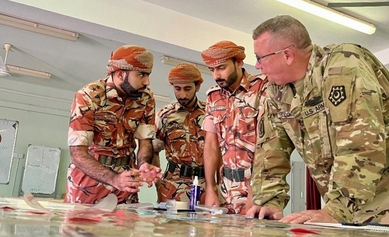
Collaboration between the US and Oman troops
In the past week, the Pentagon has reinforced its Gulf posture by deploying an additional amphibious ready group and expanding aerial surveillance missions. The USS Eisenhower, already operating near the Gulf of Oman, has conducted joint manoeuvres with British and French vessels to ensure freedom of navigation through the strait. Senior defence officials have privately acknowledged that a deliberate Iranian blockade, whether through mining operations, missile deployments on Qeshm and Abu Musa islands, or direct harassment of tankers, would constitute a red line likely to trigger a military response. Such a clash could have far-reaching consequences. A maritime standoff could quickly escalate into direct strikes on Iranian radar sites, missile batteries, and naval assets. Tehran, for its part, has repeatedly warned that American bases in the region would be 'legitimate targets' in the event of hostilities. The spectre of US troops in direct combat with Iranian forces, potentially for the first time in decades, would transform the current crisis into a broader regional war with global ramifications.
The Energy Market Response
Oil prices were among the first indicators of the crisis’s severity. Brent crude surged by more than 12% in the days following the Israeli strike, peaking at $78.45 per barrel before stabilising near the $74 mark. Analysts at Goldman Sachs have warned that a full closure of Hormuz could push prices beyond $120 per barrel, triggering inflationary shocks globally (Goldman Sachs Energy Outlook, 2025). Gas markets have also been shaken. With Qatari LNG tankers forced to reroute or delay transit, European energy prices are under renewed pressure, just as the continent was beginning to stabilise its energy mix following the Russia-Ukraine conflict. Several EU leaders have called for the activation of strategic fuel reserves and fast-tracked renewable infrastructure investments.
Global Supply Chain in Crisis
The disruption in both the Strait of Hormuz and the Red Sea has severely impacted the global logistics chain. Major shipping lines such as Maersk, MSC, and Hapag-Lloyd have rerouted vessels around Africa, increasing transit times between Asia and Europe by up to two weeks. This has led to bottlenecks at key ports, particularly in the Mediterranean and South Asia, and exacerbated container imbalances. Retailers and manufacturers are already reporting shortages of high-demand goods. Electronics manufacturers, in particular, are feeling the pinch as just-in-time inventories of semiconductors and components from East Asia are delayed. The automotive sector in Germany and Japan has announced temporary halts in production due to supply disruptions. In Africa, exporters of perishables like flowers, fruit, and coffee face steep losses as their goods are stranded at ports or rerouted inefficiently. Insurance premiums for Red Sea transits have tripled, making smaller exporters particularly vulnerable.
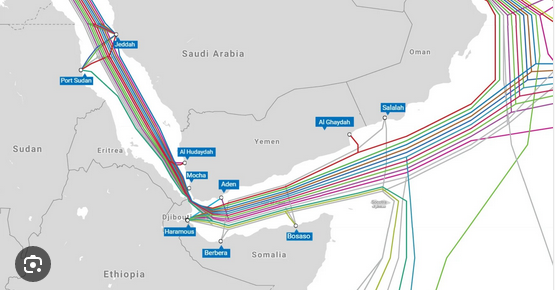
International data cables bottleneck in the seas by Houthi territory. What could possibly go wrong?
The Invisible Front: Digital Infrastructure at Risk
Beneath the surface of the Red Sea lies another form of infrastructure that is increasingly under threat: submarine internet cables. These fibre-optic lines are responsible for carrying up to 95% of global internet traffic. A sabotage operation against these cables could cripple financial markets, government communications, and cloud-based services across three continents. Earlier this year, a similar but smaller disruption occurred when unknown protagonists severed a cable off the coast of Djibouti, causing significant connectivity issues in East Africa. The idea that a non-state actor like the Houthis might now attempt something on a larger scale, potentially at Iran’s behest, has prompted military and intelligence agencies across NATO and the Gulf Cooperation Council to raise cyber-defence alerts.
Western Military and Diplomatic Response
In response to the dual threats, Western nations have moved rapidly. The United States has repositioned the USS Eisenhower carrier strike group to the Gulf of Oman, and British and French naval assets are now patrolling the Red Sea. The Pentagon has confirmed that CENTCOM has placed satellite and cyber assets on heightened alert. Meanwhile, diplomatic efforts are accelerating. NATO has convened an emergency summit to discuss the activation of Article 5 should a member state's infrastructure or vessels be directly targeted. The European Union has pledged new funding for cyber resilience and announced joint naval exercises with Gulf partners. There are also early signals of a potential multilateral maritime coalition, similar to Operation Sentinel in 2019, which may include Australia, Japan, and India. The coalition’s goal would be to guarantee freedom of navigation and protect undersea assets.
Strategic Realignments and Global Tensions
The crisis is catalysing broader geopolitical realignments. Saudi Arabia, which had been cautiously engaging with Iran diplomatically, has signalled a return to a more confrontational posture. Crown Prince Mohammed bin Salman has ordered the Saudi Navy to coordinate with US forces in protecting shipping lanes. Israel, meanwhile, has expanded its campaign, reportedly targeting IRGC facilities in Syria and Lebanon. The risk of Hezbollah, which despite last year’s war with Israel is still a potent force, joining the conflict in earnest remains high. Should this occur, a full regional war cannot be ruled out. China and Russia, both with vested interests in Middle Eastern stability, have so far adopted cautious positions. Beijing has called for restraint and emphasised the importance of freedom of navigation. Moscow, while critical of Israel’s actions, has not intervened directly. Beyond the Middle East, countries are increasingly aligning themselves with either Iran or Israel, deepening the global divide. Pakistan has notably escalated its rhetoric, threatening nuclear retaliation should Israel use nuclear weapons against Iran, a warning that adds a dangerous new dimension to the conflict. This polarisation risks expanding the crisis well beyond regional boundaries, drawing in allies and adversaries across Asia, Africa, and Europe.

28th June 1914, the assassination of Archduke Franz Ferdinand of the Austro-Hungarian Empire by a Bosnian nationalist. A backwater action that triggered a global catastrophe
The tense international environment recalls the fraught days of July 1914, just before the outbreak of the First World War are a harbinger to what is currently playing out. Then, a complex web of alliances, mutual suspicions, and nationalist fervour turned a regional assassination into a global conflagration. Today’s crisis similarly features a tangled web of military commitments, proxy actors, and high-stakes brinkmanship, where a single misstep could spiral uncontrollably.
The closure of strategic chokepoints and threats of nuclear retaliation underscore how rapidly localised conflicts can escalate into broader wars. Just as the great powers of the early 20th century were caught unprepared for the scale of their confrontation, the world now faces a similar risk, highlighting the urgent need for diplomatic intervention before the metaphorical July 1914 moment becomes reality.
What the World Must Now Confront
This crisis is a stark reminder of how quickly global vulnerabilities, long acknowledged but insufficiently addressed, can be weaponised. The simultaneous threat to maritime and digital chokepoints exposes the fragile arteries of international trade and communication. Iran’s strategy, combining asymmetric warfare and proxy disruption, marks a new chapter in hybrid conflict. The world must now adapt to a reality where kinetic, cyber, and economic threats are deeply intertwined. If the Strait of Hormuz is blocked and undersea cables are sabotaged in the Gulf of Aden, the consequences would surpass previous global shocks. The challenge ahead is not only to contain the current crisis but to build resilience before the next one erupts. And it is arguable we have passed the point of no return.
There are no winners here. Sir Edward Gray, British Foreign Secretary in August 1914 said whilst noting the uncontrollable spiral into a World War, "The lights are going out all over Europe, I doubt we will see them relit in our lifetime". We could very well be at this point in time again.

Blackadder goes Forth: the final scene
In the final scene of Blackadder, as they are facing certain death, in a moment of empathy and camaraderie Blackadder asked Captain Darling:
“How are you feeling, Darling?”
“Erm, not all that good, Blackadder. Rather hoped I'd get through the whole show; go back to work at Pratt & Sons; keep wicket for the Croydon gentlemen; marry Doris... Made a note in my diary on my way here. Simply says, ‘Bugger’.
Bugger, indeed.
Sources:
- Reuters. (2025). "Iran Threatens Closure of Hormuz After Israeli Strikes."
- Submarine Cable Map. (2024). "Global Internet Infrastructure."
- Goldman Sachs. (2025). "Energy Outlook: Hormuz Risk Scenarios."
- UNCTAD. (2024). "Global Maritime Trade and Chokepoint Vulnerabilities."
- Curtis, Elton, Atkinson (1989) “Blackadder Goes Forth”, Episode 6
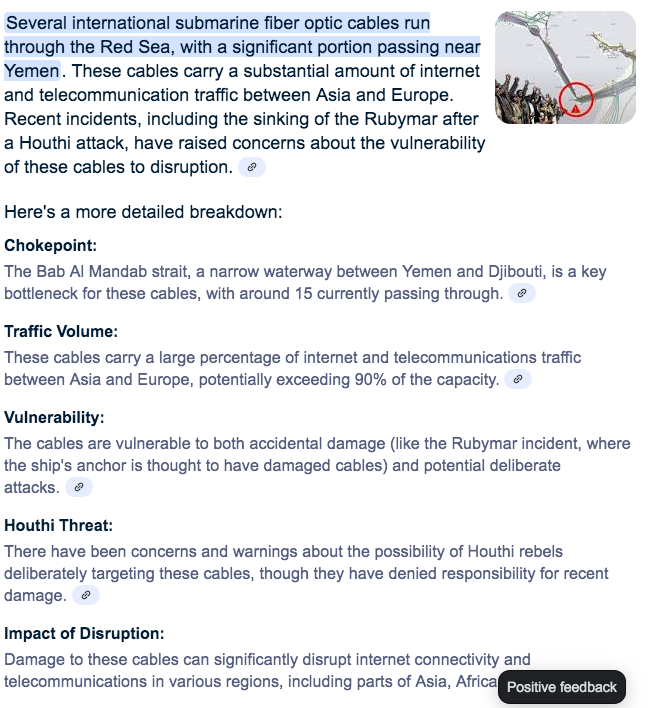
The world has gone mad. If you enjoyed reading this, please feel free to look at the rest of the blogs on www.TetleysTLDR.com. They're free to view, there's no paywall, they aren't monetised and I won't ask you to buy me a coffee. Also please free to share anything you find of interest, we only get the message out if people are aware of it. Just a leftie, standing in front of another leftie, asking to be read. All the best, Tetley

